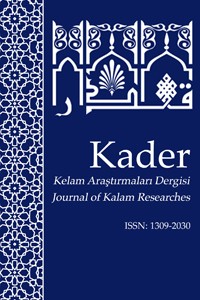Öz
In this paper, I will defend the view that the puzzle of Theseus’ ship
is not paradoxical from the viewpoint of an individual artefact-essentialist
account. After introducing two marginal/opposite solutions – spatio-temporal
continuity and original part as conditions of identity – I will argue in favour
of a revised version of spatio-temporal continuity of form account. To do this,
I will present the necessity of revision in virtue of Carter’s counter-argument
through the introduction of two possible worlds containing different
combinations of these processes. The same line of reasoning, which defends
original part as an identity criterion, will be used to challenge his argument.
Instead, an individual essential property will be presented by expressing two
significant concepts in the artefact’s identity: possessing a certain timeline
and a particular function. I will conclude that this property is the individual
essence that enables identification of single individual artefacts in terms of
temporal possibility.
Anahtar Kelimeler
Kaynakça
- Barnett, D. “The problem of Material Origins”, Noûs 39/3 (2005): 529–540.
- Brody, A. B, Identity and Essence, Princeton: Princeton University Press, 1980.
- Bulgen, Mehmet, Klasik Islam Düşüncesinde Atomculuk Eleştirileri [Criticism of Atomism in Classical Islamic Thought], İstanbul: Pasifik, 2016.
- Carter, W. R. “Artifacts of Theseus: Facts and Fission”, Australian Journal of Philosophy 61/3 (1983): 248-265. Available at: http://dx.doi.org/10.1080/00048408312350021.
- Chalmers, Alan, “Atomism from the 17th to the 20th Century”, The Stanford Encyclopedia of Philosophy (Winter 2014 Edition), ed. Edward N. Zalta, http://plato.stanford.edu/archives/ win2014/ entries/atomism-modern.
- Denkel, A. “Artifacts and Constituents”, Philosophy and Phenomenological Research 55/2 (1995): 311-322. http://www.jstor.org/stable/2108549.
- David Furley, The Greek Cosmologists: The Formation of the Atomic Theory and its Earliest Critics, New York: The Cambridge University Press, 1987.
- Hughes, C. “Same-kind Coincidence and the Ship of Theseus”, Mind, New Series 106/421 (1997): 53-67. http://www.jstor.org/stable/2254770.
- Losonsky, M. “Individual Essences”, American Philosophical Quarterly. 24/3 (1987): 253-260. http://www.jstor.org/stable/20014200.
- Lowe, E. J. “On the Identity of Artifacts”, The Journal of Philosophy 80/4 (1983): 220-232. http://www.jstor.org/stable/2026005.
- Lowe, E. J. A Survey of Metaphysics, Oxford: Oxford University Press, 2002.
- Mackie, P. How Things Might Have Been, Oxford: Oxford University Press, 2004.
- Plutarch. Plutarch's Lives, with an English Translation by Bernadotte Perrin, Cambridge MA: Harvard University Press, 1914.
- Simmons, P. “On Being the Same Ship(s)-- or Electron(s): Reply to Hughes”, Mind, New Series. 106/424 (1997): 761-767. http://www.jstor.org/stable/2254677.
- Smart, B. “How to Reidentify the Ship of Theseus”, Analysis 32/5 (1972): 145-148. http://www.jstor.org/stable/3327760.
- Warmke, B. “Artefact and Essence”, Philosophia 38 (2010): 585-614.
- Wiggins, D. Sameness and Substance, Oxford: Basil Blackwell, 1980.
Öz
Bu makalede Theseus’un Gemisi muammasının tekil özcü-eser
bakış açısından paradoksal olmadığı görüşünü savunmaya çalışacağım. Eserlerin
özdeşleştirilmesi için zaman-uzamsal süreklilik ve orijinal parçaları şart
olarak sunan, böylelikle bu muammaya getirilen iki çatışan çözümü ortaya
koyduktan sonra; zaman-uzamsal süreklilik argümanının değişik bir versiyonunu
savunmak için deliller getireceğim. Bunda muvaffak olmak için, bu değişikliğin
gerekliliğinin; Carter’ın yenileme/tekrardan inşa etme süreçlerine dikkati, bu
süreçlerin iki ayrı alternatif dünyada gerçekleşen kombinasyonları
aracılığıyla, çeken karşı-delili sonucu olduğunu göstereceğim. Bu kapsamda,
orijinal parçaların (yani salt maddenin) özdeşlik kriteri olduğunu savunan aynı
mantık onun delilini karşılamak için kullanılacaktır. Ayrıca, Theseus’un Gemisi
örneğini muammaya ve paradoksa çeviren sürekli olmayan varoluş sorunu da
zaman-uzamsal süreklilik argümanını geliştirmek için kullanılacaktır. Bu
bağlamda, ferdi bir temel özellik ortaya konulacaktır ki bu da eser özdeşliği
için iki mühim kavramı ifade edecektir: belirli bir zamansal çizelgeye ve
fonksiyona sahip olmak. Sonuç olarak, bu özelliğin ferdi tekil eserlerin
özdeşleştirilmesini sağlayan ferdi öz olduğunu ortaya koyacağım.
Kaynakça
- Barnett, D. “The problem of Material Origins”, Noûs 39/3 (2005): 529–540.
- Brody, A. B, Identity and Essence, Princeton: Princeton University Press, 1980.
- Bulgen, Mehmet, Klasik Islam Düşüncesinde Atomculuk Eleştirileri [Criticism of Atomism in Classical Islamic Thought], İstanbul: Pasifik, 2016.
- Carter, W. R. “Artifacts of Theseus: Facts and Fission”, Australian Journal of Philosophy 61/3 (1983): 248-265. Available at: http://dx.doi.org/10.1080/00048408312350021.
- Chalmers, Alan, “Atomism from the 17th to the 20th Century”, The Stanford Encyclopedia of Philosophy (Winter 2014 Edition), ed. Edward N. Zalta, http://plato.stanford.edu/archives/ win2014/ entries/atomism-modern.
- Denkel, A. “Artifacts and Constituents”, Philosophy and Phenomenological Research 55/2 (1995): 311-322. http://www.jstor.org/stable/2108549.
- David Furley, The Greek Cosmologists: The Formation of the Atomic Theory and its Earliest Critics, New York: The Cambridge University Press, 1987.
- Hughes, C. “Same-kind Coincidence and the Ship of Theseus”, Mind, New Series 106/421 (1997): 53-67. http://www.jstor.org/stable/2254770.
- Losonsky, M. “Individual Essences”, American Philosophical Quarterly. 24/3 (1987): 253-260. http://www.jstor.org/stable/20014200.
- Lowe, E. J. “On the Identity of Artifacts”, The Journal of Philosophy 80/4 (1983): 220-232. http://www.jstor.org/stable/2026005.
- Lowe, E. J. A Survey of Metaphysics, Oxford: Oxford University Press, 2002.
- Mackie, P. How Things Might Have Been, Oxford: Oxford University Press, 2004.
- Plutarch. Plutarch's Lives, with an English Translation by Bernadotte Perrin, Cambridge MA: Harvard University Press, 1914.
- Simmons, P. “On Being the Same Ship(s)-- or Electron(s): Reply to Hughes”, Mind, New Series. 106/424 (1997): 761-767. http://www.jstor.org/stable/2254677.
- Smart, B. “How to Reidentify the Ship of Theseus”, Analysis 32/5 (1972): 145-148. http://www.jstor.org/stable/3327760.
- Warmke, B. “Artefact and Essence”, Philosophia 38 (2010): 585-614.
- Wiggins, D. Sameness and Substance, Oxford: Basil Blackwell, 1980.
Ayrıntılar
| Konular | Din Araştırmaları |
|---|---|
| Bölüm | MAKALELER |
| Yazarlar | |
| Yayımlanma Tarihi | 15 Ocak 2017 |
| Yayımlandığı Sayı | Yıl 2017 Cilt: 15 Sayı: 1 |
ISSN: 1309-2030 KADER Kelam Araştırmaları Dergisi


